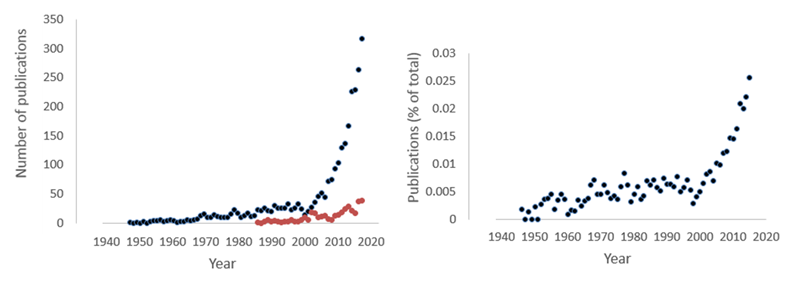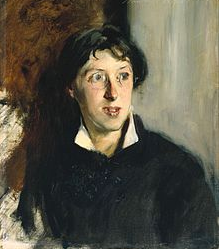 Empathy is becoming a 21st century biomedical fashion, judging by the number of papers on the subject (figure). But the concept is not new. The word is first recorded in English in the Philosophical Review in 1895, in a summary by E L Hinman of a paper by Kurd Lasswitz, a Kantean philosopher and science fiction writer, who influenced Jorge Luis Borges. Lasswitz used the word Einfühlung, “aesthetic sympathy”, which Robert Vischer had coined in 1873. Hinman translated it as “empathy”, “a physical quantity, a physiological brain-function, . . . the relation of the whole energy at any change of the central organ to the intensity.” There were, however, earlier instances of Empathie in German, borrowed from French.
Empathy is becoming a 21st century biomedical fashion, judging by the number of papers on the subject (figure). But the concept is not new. The word is first recorded in English in the Philosophical Review in 1895, in a summary by E L Hinman of a paper by Kurd Lasswitz, a Kantean philosopher and science fiction writer, who influenced Jorge Luis Borges. Lasswitz used the word Einfühlung, “aesthetic sympathy”, which Robert Vischer had coined in 1873. Hinman translated it as “empathy”, “a physical quantity, a physiological brain-function, . . . the relation of the whole energy at any change of the central organ to the intensity.” There were, however, earlier instances of Empathie in German, borrowed from French.


In 1909, the word was used by Edward Titchener to mean “the quality or power of projecting one’s personality into or mentally identifying oneself with an object of contemplation, and so fully understanding or appreciating it” (OED), and the idea was popularised by a writer of supernatural and historical fiction, Vernon Lee (real name Violet Paget, picture), in her writings on art and aesthetics. The current simpler meaning of the ability to understand and appreciate another person’s feelings did not emerge until the 1940s.
Picture: A portrait of Vernon Lee (Violet Paget, 1856–1935) by John Singer Sargent (1881)
The Greek verb πάσχειν meant to have something done or happen to you, to be affected by, to suffer. The noun πάθος meant something that happens, what one experiences (good or bad), an incident or accident, hence a misfortune or calamity, and so emotion or passion. The adjective παθῐκός meant [sexually] passive and παθητικός capable of emotion, sensuous.
Pathos is “that quality in speech, writing, music, or artistic representation . . . which excites a feeling of pity or sadness” (OED). It has also rarely been used to mean bodily or mental suffering. Pathetic, first recorded in 1591, originally meant exciting a feeling of pity, sympathy, or sadness. John Ruskin coined the term “pathetic fallacy” (“the attribution of human response or emotion to inanimate nature”) in discussing the relation between emotion and art: “All violent feelings have the same effect. They produce in us a falseness in all our impressions of external things, which I would generally characterize as the ‘Pathetic fallacy’.” (Modern Painters, 1856). The emotional experience in art was also referred to as Einfühlung by the philosopher Theodor Lipps, who influenced Freud and Vernon Lee.
The first citation in OED of pathetic meaning miserably inadequate or ridiculous is from 1900. It was this sense that led to the idea, distinct from that of Ruskin, of “pathetic art”, a term coined in the 1990s to refer to art that expresses failure or inadequacy.
“Pathic” was a 17th century noun meaning a catamite, implying one who is homosexually passive, but in the mid 19th century it came to mean pertaining to suffering or disease. At about the same time the suffix -pathy, which had originally implied feeling, came to be used to indicate a disease or its treatment.
When the suffix -pathy means disease, the corresponding adjective almost always ends in -pathic. Of about 100 such words, from adenopathic to zoopathic, there are only two exceptions, idiopathy and isopathy, in which both -pathic and (albeit rarely) -pathetic occur. But when -pathy means feeling, the corresponding adjective can end in -pathic or
-pathetic. Of about a dozen such words, only six are used commonly today. In four of these the adjective ends in -pathetic (antipathetic, apathetic, sympathetic, and parasympathetic); the exceptions are telepathy (telepathic and telepathetic) and empathy (empathic and empathetic).
Telepathic and telepathetic are contemporaneous (first citations in OED from 1884 and 1892, respectively). Telepathic is more common than telepathetic, both in bioscience papers (41 instances versus 0 in PubMed) and in general (56 versus 1 in the British National Corpus). Empathic and empathetic are also contemporaneous (first citations 1909 and 1912). Empathic is more common in bioscience papers (2678 instances versus 794 in PubMed), but not in general, although the sample is small (19 versus 28 in the British National Corpus).
So, telepathic and empathic are the preferred adjectival forms.
Next time I shall discuss the difference between sympathy and empathy and explore modern views of empathy, its relevance to clinical medicine, and whether it can be taught.
Thanks to Simon Cocksedge for an empathic question.
Jeffrey Aronson is a clinical pharmacologist, working in the Centre for Evidence Based Medicine in Oxford’s Nuffield Department of Primary Care Health Sciences. He is also president emeritus of the British Pharmacological Society.
Competing interests: None declared.
